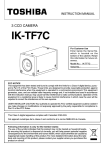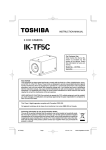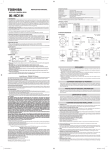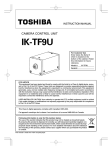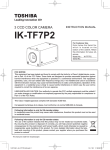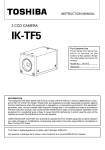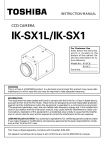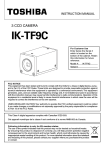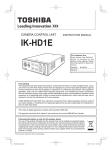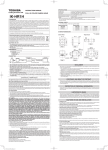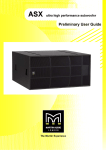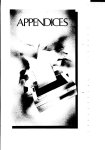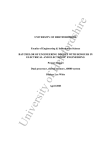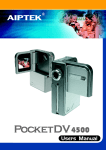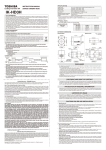Download Toshiba ik-tf7u Camera Accessories User Manual
Transcript
INSTRUCTION MANUAL
CAMERA CONTROL UNIT
IK-TF7U
For Customer Use
Enter below the Serial #
which is located on the
bottom of the cabinet. Retain
this information for future
reference.
Model #:
IK-TF7U
Serial #:
FCC NOTICE
This equipment has been tested and found to comply with the limits for a Class A digital device, pursuant to Part 15 of the FCC Rules. These limits are designed to provide reasonable protection against
harmful interference when the equipment is operated in a commercial environment. This equipment
generates, uses, and can radiate radio frequency energy and, if not installed and used in accordance
with the instruction manual, may cause harmful interference to radio communications. Operation of this
equipment in a residential area is likely to cause harmful interference in which case the user will be
required to correct the interference at his own expense.
USER-INSTALLER CAUTION: Your authority to operate this FCC verified equipment could be voided
if you make changes or modifications not expressly approved by the party responsible for compliance
to Part 15 of the FCC Rules.
This Class A digital apparatus complies with Canadian ICES-003.
Cet appareil numérique de la classe A est comforme à la norme NMB-003 du Canada.
Following information is only for EU-member states:
The use of the symbol indicates that this product may not be treated as household waste.
By ensuring this product is disposed of correctly, you will help prevent potential negative consequences for the environment and human health, which could otherwise be caused by inappropriate waste handling of this product. For more detailed information about the takeback
and recycling of this product, please contact your supplier where you purchased the product
or consult.
This manual is made from 100% recycled paper.
SAFETY PRECAUTIONS
Safety icons
This manual contains safety instructions that must be observed in order to avoid potential
hazards that could result in personal injuries, damage to your equipment, or loss of data.
These safety cautions have been classified according to the seriousness of the risk, and the
icons highlight these instructions as follows:
Indicates a potentially hazardous situation which, if not avoided, could
result in death or serious injury.
Indicates a potentially hazardous situation which, if not avoided, may
result in minor or moderate injury.
Indicates a potentially hazardous situation which, if not avoided, may
result in property damage.
Stop operation immediately if any abnormality or defect occurs.
Use during an abnormal condition; such as emitting smoke, burning odors, damage from dropping invasion of foreign objects, etc. may result in fire and/or electric shock. Immediately disconnect the power source and contact your dealer.
Avoid installing in a shower room or a bathroom.
This may result in fire and/or electric shock.
Do not operate in places where the product may get wet.
This may result in fire and/or electric shock.
Do not repair, disassemble and/or modify by yourself.
This may result in fire and/or electric shock. Be always sure to contact your dealer
for internal repair, check and cleaning of the product.
Use the specified power supply.
Otherwise, fire or electrical shock may occur.
Don’t place anything on top of the unit.
Foreign materials, such as metals or liquids into the product may result in fire
and/or electrical shock.
Do not put the product on an unstable, slanted on vibrating surface.
The product dropping or falling may cause serious injury.
Do not touch the product or any connection cables during a thunderstorm.
This may result in shock.
2
Note the following instructions when installing.
• Do not cover the product with any material.
• Do not place the product on any confined Inflammable material such as a
carpet or blanket.
• Do not place the product in a narrow space, as this may cause heat to buildup
inside the product.
Failure to follow the above cautions may result in fire.
Do not place the product in direct sunshine and/or high temperature.
Temperature build up inside the product may result in fire.
Avoid placing in humid, smoky, vaporized or dusty places.
This may result in fire and/or electric shock.
Ask your dealer to perform a periodical check and internal cleaning (approx.
once every five years).
Dust inside the product may result in fire. For check and cleaning cost, please
consult your dealer.
The following description is for that a camera head “IK-TF7H” connected to this camera control unit.
Do not point the lens directly at the sun and/or intensive light such as direct sunlight, etc.
Focusing of the light may cause eye injury and/or fire.
Disclaimer
We disclaim any responsibility and shall be held harmless for any damages or losses incurred by the
user in any of the following cases:
1. Fire, earthquake or any other act of God; acts by third parties; misuse by the user, whether intentional or accidental; use under extreme operating conditions.
2. Malfunction or non-function resulting in indirect, additional or consequential damages, including
but not limited to loss of expected income and suspension of business activities.
3. Incorrect use not in compliance with instructions in this instruction manual.
4. Malfunctions resulting from misconnection to other equipment.
5. Repairs or modifications made by the user or caused to be made by the user and carried out by
an unauthorized third party.
6. Notwithstanding the foregoing, Toshiba’s liabilities shall not, in any circumstances, exceed the
purchase price of the product.
Limitation of Usage
The product is not designed for any “critical applications.” “Critical applications” means life support
systems, exhaust or smoke extraction applications, medical applications, commercial aviation, mass
transit applications, military applications, homeland security applications, nuclear facilities or systems or any other applications where product failure could lead to injury to persons or less of life or
catastrophic property damage. Accordingly, [Toshiba/TAIS] disclaims any and all liability arising out
of the use of the product in any critical applications.
Protection of Personal Information
Images taken by the camera that reveal the likeness of an individual person may be considered
personal information. To disclose, exhibit or transmit those images over the internet or otherwise,
consent of the person may be required.
3
Copyright and Right of Portrait
There may be a conflict with the Copyright Law and other laws when a customer uses, displays,
distributes, or exhibits an image picked up by the camera without permission from the copyright
holder. Please also note that transfer of an image or file covered by copyright is restricted to use
within the scope permitted by the Copyright Law.
TABLE OF CONTENTS
1. CAUTIONS ON USE AND INSTALLATION ..... 5
(4. 4) Changing B pedestal ........................ 22
(4. 5) Changing the shading
correction mode ............................... 23
(4. 6) Changing the manual shading correction
seting ................................................ 23
2. COMPONENTS ................................................ 5
3. NAMES AND FUNCTIONS .............................. 6
4. CONNECTION .................................................. 7
4. 1 Standard Connection ................................ 7
4. 2 Cautions on Connection ........................... 7
4. 3 Connector Pin Assignments ..................... 7
( 5 ) SYNC ...................................................... 23
(5. 1) Adjusting horizontal phase ............... 23
( 6 ) OPTION .................................................. 23
(6. 1) Changing serial communication baud
rate .................................................... 23
5. OPERATION ..................................................... 8
5. 1
5. 2
5. 3
5. 4
Automatic Black Balance .......................... 8
White Balance ........................................... 8
Gain ........................................................ 10
Sading Correction ................................... 10
6. ITEMS CONTROLLED BY THE SCREEN
DISPLAY ......................................................... 11
7. MODE SETTING BY THE SCREEN DISPLAY .. 12
7. 1 Using the Menus ..................................... 12
7. 2 Menus ..................................................... 13
( 1 ) SHUTTER (Electronic shutter) ................ 13
(1. 1) Changing the setting in
MANU mode .....................................
(1. 2) Changing the setting in
SS (synchro. scan) mode .................
(1. 3) Changing the setting in
E.TRG mode .....................................
(1. 3. 1) Changing the setting in
1P SNR mode ...............................
(1. 3. 2) Changing the setting in
1P SR mode .................................
(1. 3. 3) Changing the setting in
PW SNR mode .............................
(1. 3. 4) Changing the setting in
PW SR mode ................................
(1. 3. 5) Changing the setting in
RR mode .......................................
14
15
Returning to factory settings ...................
Synchro. Scan Operation ........................
Setting by 1H ..........................................
Setting by the frame ................................
E. TRG (External trigger) .........................
1P SNR
(1 Pulse Trigger Sync Non Reset) ...........
24
24
24
24
25
25
(1. 1) 1 Pulse Trigger SYNC-NON RESET
Picture Output Timing ...................... 25
( 2 ) 1P SR (1 Pulse Trigger Sync Reset) ....... 26
(2. 1) 1 Pulse Trigger SYNC-RESET Picture
Output Timing ................................... 26
( 3 ) PW SNR (Pulse width trigger
SYNC-NON RESET) .............................. 27
(3. 1) Pulse Width Trigger SYNC-NON RESET
Picture Output Timing ...................... 27
16
( 4 ) PW SR (Pulse width trigger
SYNC-RESET) ....................................... 28
16
(4. 1) 1 Pulse Width Trigger SYNC-RESET
Picture Output Timing ...................... 28
17
( 5 ) RR (Reset restart) .................................. 29
18
(5. 1) Long Term Exposure ........................ 29
(5. 2) Input Timing Chart Example ............ 29
19
19
( 2 ) GAIN (Video gain) ................................... 20
(2. 1) Changing the setting in GAIN .......... 20
( 3 ) WHT BAL (White balance) ...................... 21
(3. 1) Changing the setting in AWB
(Automatic White Balance) mode .... 21
(3. 2) Changing the setting in MANU
(Manual) mode ................................. 21
( 4 ) PROCESS .............................................. 22
(4. 1) Changing gamma correction ............ 22
(4. 2) Changing master pedestal ............... 22
(4. 3) Changing R pedestal ........................ 22
4
(7)
7. 3
(1)
(2)
7. 4
(1)
7. 5 Partial Read ............................................
( 1 ) Partial Scanning OFF
(All pixels scanning) ................................
( 2 ) Partial Scanning ON ...............................
( 3 ) When Partial Scanning Mode is ON .......
7. 6 External Sync ..........................................
( 1 ) External sync signal polarity ...................
( 2 ) External sync frequency range ...............
( 3 ) Using the unit with external sync signal ..
30
30
30
30
31
31
31
31
(3. 1) H (horizontal) phase adjustment ...... 31
8. INPUT OUTPUT SIGNAL SPECIFICATIONS .... 32
( 1 ) HD Input Specifications .......................... 32
( 2 ) VD Input Specifications ........................... 32
( 3 ) Trigger Pulse Specifications .................... 32
( 2 ) Vertical Output Waveform Timing Chart ...
( 4 ) External HD/VD Input Phase
10. SPECIFICATIONS .......................................
Specifications .......................................... 32
11. EXTERNAL APPEARANCE DIAGRAM ......
9. OUTPUT WAVEFORM TIMING CHART ............. 33
12. BEFORE MAKING A SERVICE CALL ........
( 1 ) Horizontal Output Waveform Timing Chart ... 33
33
34
35
35
This product is 3CCD color camera with digital video output.
1. CAUTIONS ON USE AND INSTALLATION
•
Handling the unit.
Do not drop, jolt, or vibrate, as this may result in
damage to the unit. This may cause problems.
Treat the camera cables carefully to prevent cable
problems, such as breaks in the cable and loose
connections.
•
Be particularly careful when using in places exposed to direct sunlight. When shooting in hot
places, depending on the conditions of the object
and the camera (for example when the gain is increased), noise in the form of vertical strips or
white dots may occur. This is not a malfunction.
When not using the camera for extended periods of time.
•
•
Places near gasoline, benzene, or paint thinner.
Places subject to strong vibration.
Places containing chemicals (such as pesticides),
rubber or vinyl products for extended periods of
time.
Handling of the camera head and protection
cap.
Keep the camera head and protection cap away
from as they may pose a choking hazard. The protection cap protects the image sensing plane when
the lens is removed from the camera head, do not
discard.
•
When cleaning the camera.
Unplug the power source before cleaning. Clean
with a soft dry cloth only. Do not use chemicals or
chemically treated cloths. Chemicals may damage
coatings and printed letters. When cleaning the
lens, use lens cleaning paper.
Avoid using or storing the camera in the following places:
Places filled with highly flammable and corrosive
gas.
Moire
A moire pattern is an interference pattern generated when two repetitive line patterns overlap. This
is not a malfunction. Eliminating the repetitive line
patterns, or aligning the two patterns, will eliminate the moire.
Switch the control unit off and disconnect the
power supply.
•
Do not shoot intense light.
If there is an intense light at a location on the
screen such as a spot light, a blooming and smearing may occur. When intense light enters, vertical
stripes may appear on the screen. This is not a
malfunction. Ghosts may occur when there is an
intense light near the object. In this case, change
the shooting angle.
Operating ambient temperature and humidity.
Do not use the camera in places where temperature and humidity exceed the specifications. Picture quality will deteriolate and internal parts may
be damaged.
•
•
Install the camera in a location free from noise.
If the camera or the cables are located near power
utility lines or a TV, etc. undesirable noise may
appear on the screen. In such a case, try to change
the location of the camera or the cable wiring.
•
The following descriptions are for that a camera head
“IK-TF7H” connected to this camera control unit.
•
Installation without a tripod.
Before installing the camera head and the camera control unit, make sure that the location can
withstand the total weight of the camera head and
the camera control unit.
If this is not the case, reinforce the area to prevent the unit from dropping, which may result in
damage to the unit or personal injury.
2. COMPONENTS
(1) Camera Control Unit ...................................................................................................................... 1
(2) Accessories
(a) Instruction manual ................................................................................................................... 1
5
3. NAMES AND FUNCTIONS
8 DC IN 12V terminal
1 Camera cable for
‘IK-TF7H’ terminal
2 DISP button
4 MENU UP button
(AWB)
6 DATA UP (AWB) button
DISP
MENU DATA
DC IN 12V
PAGE
7 DATA DOWN button
5 MENU DOWN button
9 DIGITAL terminal
3 PAGE button
[ Front ]
10
[ Rear ]
11
[ Bottom ]
1 Camera cable for ‘IK-TF7H’ terminal
2 DISP button
Where the camera cable for ‘IK-TF7H’ is connected.
3 PAGE button
4 MENU UP button
To switch and select menus.
5 MENU DOWN button
6 DATA UP (AWB) button
To select the function to be confirmed or changed on the menu.
7 DATA DOWN (ABB) button
To change the value of the function selected by the MENU (UP/DOWN)
button. (Also used when using ABB)
8 DC IN 12V terminal
9 DIGITAL terminal
Accept a DC power input (12V).
To change the display mode.
To select the function to be confirmed or changed on the menu.
To change the value of the function selected by the MENU (UP/DOWN)
button. (Also used when using AWB.)
8-bit RGB, digital signal, and sync signal are output in the Camera
Link format.
Trigger signal is input.
Mode switching signal for partial scanning is input.
Accepts serial communication control signal.
! Mounting holes M3
" Mounting holes M2
6
Used to fix the camera.
Used to fix the camera.
4. CONNECTION
4. 1 Standard Connection
Camera control unit
Cable
Camera cable
(option)
for IK-TF7U
IK-TF7U
(option)
Lans
(option)
IK-TF7H
(option)
DC IN 12V
Monitor
Frame grabber board,
image process
equipment etc.
DC power
supply (option)
When connection the frame grabber
board, image process equipment, etc
with power supply function, refer to the
item “4.2 Caution on Connection”.
4. 2 Cautions on Connection
• Only use optional camera head model # IK-TF7H with this camera controller.
The use of another head may cause damage to the control unit and camera head.
• When connecting the camera cables, be sure to turn off the camera control unit and any other equipment
connected to it.
• For DC power supply connecting to DC IN 12V terminal, use UL listed and/or CSA approved ungrounded
type AC adaptor with the specifications described below.
Power supply voltage
: 12V DC±10%
Current rating
: More than 830mA
Ripple voltage
: Less than 50mV(p–p)
• To connect DC IN 12V terminal, use the following connector listed below.
Connector
: HR10A–7P–4S by HIROSE electronics Co., Ltd
Pins 1, 2 : 12V ,
Pins 3, 4 : GND
• If the securing screw on the connector of the camera cable loosens, noise may appear on the screen.
Be sure to tighten the connector completely.
• Use the standard cable for Camera Link.
• Input DC power (12V) either DC IN 12V terminal or DIGITAL terminal. If DC power is supplied input
from both terminals, it may cause trouble.
• More than 830mA is necessary for proper functioning of the unit. Use power line with sufficient quantities of current rating. The unit dose not support PoCL standard.
4. 3 Connector Pin Assignments
DC IN 12V
1
2
3
4
+12V
+12V
GND
GND
1
4
2
3
Connector used:
HR10A-7R-4PB
(HIROSE electronics
Co. Ltd) or equivalent.
DIGITAL
Function
13
2
3
4
5
6
7
8
9
10
GND
X0X1X2XclkX3SerTC+
SerTFCCC1CC2+
14
15
16
17
18
19
20
21
22
23
GND
X0+
X1+
X2+
Xclk+
X3+
SerTCSerTFC+
CC1+
CC2-
11
12
1
CC3CC4+
+12V
24
25
26
CC3+
CC4+12V
I/O
–
O
O
O
O
O
Serial communication control (RXD)
Serial communication control (TXD)
Trigger pulse input
Partial scanning control
External HD input
External VD input
I
O
I
I
I
I
13
1
26
14
Connector used:
12226-51000-00
(3M) or equivalent.
–
7
5. OPERATION
A camera head “IK-TF7H” is supposed to be connected to this camera control unit from this section.
1 Refer to the item " 4. CONNECTION", connect each equipment correctly.
2 Turn on the connected equipment and the power source of the camera.
3 When using the camera for the first time and when replacing the camera cable and the camera head, be
sure to operate the ABB adjustment refer to the item "Automatic Black Barance".
4 Aim the lens at the object, adjust the lens iris adjustment, focus adjustment, etc..
5 Refer to the item "5.1 White Balance", make the adjustment.
6 Refer to the items "7. MODE SETTING BY ON SCREEN DISPLAY", select the necessary items.
5. 1 Automatic Black Balance
Black balance adjustment is necessary to get the correct black picture level.
• Close the lens iris and put the lens cover on.
• If the index menu/menu is displayed, press the [DISP] button to disable or the character display.
• Hold the [DATA DOWN] button for approx. 1 second.
• When the black balance adjustment operation starts, the character ABB blinks on the screen.
• When the black balance adjustment operation finishes, the character ABB stops blinking and the result
appears for approx. 1 second.
• When the black balance adjustment performed, set the electronic shutter, Synchro. Scan, partial read to
OFF, and do not operate trigger mode or external sync.
• When using the camera for the first time and when replacing the camera cable and the camera head, be
sure to operate the ABB adjustment refer to the item "Automatic Black Barance".
Display
ABB OK
ABB NG
CLOSE LENS
ABB NG
Meaning
Automatic black balance adjustment finished correctly.
Automatic black balance adjustment cannot be performed because the
lens iris is open. Close the lens iris.
Automatic black balance adjustment cannot be performed.
Operate the automatic black balance again.
5. 2 White Balance
For the white balance adjustment of this unit, AWB (Automatic White Balance) and MANU (Manual white
balance) adjustments are provided. To select the desired mode, refer to the items "7.2 (3) WHT BAL (White
balance)" and "7. MODE SETTING BY ON SCREEN DISPLAY".
Outline
Note
8
AWB
(Automatic White Balance)
Adjust white balance by displaying the
white object inside the area set by AWB
menu and pressing the [DATA UP] button.
When the shutter mode is E.TRG, AWB is
not available.
MANU
(Manual White Balance)
Adjust the white balance manually using
the WHT BAL menu while shooting the
white object.
Adjustment is performed by confirming
with a monitor etc.
1 AWB (Automatic white balance)
• Set the MODE to AWB on the WHT BAL menu.
Perform the C.TEMP (color temperature conversion) setting, if necessary.
(Refer to the item "7.2 (3) WHT BAL (White balance)".)
3200K : Appropriate for indoor shooting.
5600K : Appropriate for outdoor shooting.
• If the index menu/menu is displayed, press the [DISP] button to disable the character display on the
menu.
• Shoot a known white object that fills the screen and push [DATA UP] button for approx. 1 second.
• The character AWB blinks on the screen when the AWB starts.
• The character AWB stops blinking when the AWB finishes, and the result is displayed for approx. 1
second.
Result displayed
AWB OK
AWB NG LEVEL
LOW
AWB NG
LEVEL HIGH
AWB NG
C. TEMP LOW
AWB NG
C. TEMP HIGH
AWB NG
NOT AVAILABLE
AWB NG
Meaning
Automatic white balance adjustment finished correctly.
Automatic white balance adjustment cannot be performed because the
video level is too low.
Obtain the proper video level.
Automatic white balance adjustment cannot be performed because the
video level is too high.
Obtain the proper video level.
Automatic white balance adjustment cannot be performed because the
color temperature is too low.
If the C.TEMP is set to 5600K, set to 3200K.
If the message appears with the C.TEMP set to 3200K, change the
illumination or use a color temperature conversion filter.
Automatic white balance adjustment cannot be performed because the
color temperature is too high.
If the C.TEMP is set to 3200K, set to 5600K.
If the message appears with the C.TEMP set to 5600K, change the
illumination or use the color temperature conversion filter.
Automatic white balance adjustment cannot be performed because the
shutter speed mode is E.TRG mode.
Automatic white balance adjustment cannot be performed for other
reasons. Such as no white area is included in an object, etc.
2 MANU (Manual white balance)
• Set the MODE to MANU on the WHT BAL menu.
(Refer to the item "7.2 (3) WHT BAL (white balance)".)
• Shoot a known white object, adjust the white balance adjusting the levels of R GAIN and B GAIN on the
menu, confirming with a monitor etc.
(Refer to the item "7.2 (3) (3.2) Changing each setting in MANU (Manual) mode".)
9
5. 3 Gain
When the image is dark even if the lens iris is open, change the gain (video gain) to get the proper video level.
For the gain adjustment of the unit, MANU (Manual) and OFF (0 dB) modes are provided. Select the mode on
the GAIN menu. (Refer to the item "7.2 (2) GAIN (Video gain)".)
1 MANU (Manual gain)
Gain adjustment is performed on the GAIN menu. The adjustment range is from 0dB to 18dB in 1dB steps.
(Refer to the item "7.2 (2) (2.1) (a) Changing the gain in MANU mode".)
2 OFF
Gain is fixed at 0 dB.
5. 4 Shading Correction
Due to the lens used or the environmental condition, vertical color shading may occur at the top and bottom of
the screen. In this case, the shading correction can decrease the color shading. For the shading correction of
the unit, MANU (Manual shading correction) and OFF (no shading correction) modes are provided. Select the
mode on the PROCESS menu. (Refer to the item "7.2 (4) (4.5) Changing the shading correction mode".)
1 MANU (Manual Shading)
Adjust the correction amount on the PROCESS menu by confirming with a monitor or a waveform monitor.
(Refer to the "7.2 (4) (4.6) Changing the manual shading correction setting".)
2 OFF
The status is no shading correction.
* The shading correction is effective when the lens iris or zoom ratio is fixed. Use the unit with SHAD.
OFF for variable lens conditions.
10
6. ITEMS CONTROLLED BY THE SCREEN DISPLAY
Item
MODE
E. TRG
MANU speed
Electronic shutter
Syncro. Partial read OFF
scan.
Partial read 40fps
Partial read 50fps
Partial read 60fps
Partial read 70fps
Partial read 80fps
Partial read 90fps
Partial read
Gain
White
balance
Process
Sync Option
Trigger
(1P SNR/SR)
Trigger
(PW SNR/SR)
1P
exposure time
MODE
MANU
MODE
Color temperature
MANUAL R GAIN
MANUAL B GAIN
GAMMA
Master pedestal
R pedestal
B pedestal
Shading correction
mode
Manual shading
correction
H phase adjustment
Baud rate
Available selections
MANU, SS, E. TRG
1P SNR, 1P SR, PW SNR, PW SR, RR
OFF, 1/100s, 1/250s, 1/500s, 1/1000s, 1/2000s,
1/4000s, 1/10000s, 1/25000s, 1/50000s, 1/1000000s
1H/796H~795H/796H, OFF, 2FRM~512FRM
1H/580H~579H/580H, OFF, 2FRM~512FRM
1H/465H~464H/465H, OFF, 2FRM~512FRM
1H/387H~386H/387H, OFF, 2FRM~512FRM
1H/332H~331H/332H, OFF, 2FRM~512FRM
1H/290H~289H/290H, OFF, 2FRM~512FRM
1H/258H~257H/258H, OFF, 2FRM~512FRM
OFF, 40fps, 50fps, 60fps, 70fps, 80fps, 90fps,
E40fps, E50fps, E60fps, E70fps, E80fps, E90fps
Preset value
(Factory setting)
MANU
1P SNR
OFF
OFF
OFF
,
,
0.01ms~30ms
MANU, OFF
0dB~18dB
AWB, MANU
3200K, 5600K
-100~0~100
-100~0~100
ON, OFF
-64~0~64
-64~0~64
-64~0~64
MANU, OFF
30 ms
OFF
0dB
AWB
3200K
0
0
OFF
0
0
0
MANU
-128~0~127
0
-100~0~100
0
9600 bps, 19200 bps
9600 bps
11
7. MODE SETTING BY THE SCREEN DISPLAY
Various settings can be controlled on the unit by using the on screen menu displayed on the monitor. The
contents once set are memorized even if the power source is turned off, so it is unnecessary to set again when
using the unit next time. When the setting is performed, select the menu of the item to be set.
7. 1 Using the Menus
When the power is turned on, the normal screen showing only the video signal appears. Change the output to
each screen (video signal output, Index menu, and menus) by using the [DISP], [PAGE], [MENU UP], and
[MENU DOWN] buttons.
* A menu is selected when pushing the [PAGE] button after moving the "→" on the screen by the [MENU UP],
[MENU DOWN] button while the Index menu is displayed.
POWER ON
Video signal output
Index menu
DISP
DISP
DISP
PAGE
PAGE
Menues
PAGE
SHUTTER
MANU
SS
E. TRG
1P SR
E. TRG
1P SNR
E. TRG
PW SR
E. TRG
PW SNR
E. TRG
RR
12
WHT BAL
GAIN
PAGE
MANU
OFF
PAGE
AWB
MANU
PROCESS
SHAD. PAGE
PAGE
MANU
SHAD.
OFF
SYNC
INT
EXT
OPTION
PAGE
BAUD
RATE
7. 2 Menus
• Select the menu to change the setting by referring to the item "7.1 Using the Menus".)
• When the [MENU UP], [MENU DOWN] buttons are pushed, the "→" on the screen moves up and down.
Move the "→" to the item whose setting you wish to change.
Note:
When performing the mode setting in the menu display while selecting ON in "PART" (Partial Read:
refer to page 30) and E.TRG in "MODE", the screen display and camera operation switch to normal
mode. After close the MENU, they return to previous mode.
( 1 ) SHUTTER (Electronic shutter)
The electronic shutter has three modes; MANU (Manual), SS (Synchro. Scan), E.TRG (External trigger).
Move the "→" to "MODE" and push [DATA UP], [DATA DOWN] button to select the desired mode among
"MANU", "SS", "E.TRG".
MANUAL
:
It is possible to select the exposure time from eleven speed setting; OFF, 1/100s, 1/250s,
1/500s, 1/1000s, 1/2000s, 1/4000s, 1/10000s, 1/25000s, 1/50000s, 1/100000s.
Note:
When setting a rapid shutter speed, sensitivity degrades according to the speed.
When a discharging light such as fluorescent lamp, etc. is used for the illumination,
the flicker may be large.
SS
:
Shutter speed can be set by the horizontal scanning time (1H) unit or by the frame unit.
E.TRG
:
Exposure is performed and images are output by external trigger. E.TRG includes the five
modes described below. (For details of specifications, refer to the item “7.4 E.TRG
(External trigger)”.)
• 1P SNR (1 Pulse Sync Non Reset)
The charge begins to accumulate after the trigger pulse is received, and 1 frame images
are output according to the internal vertical sync signal timing. The exposure/accumulation time can be set from 0.01 to 30 ms. The trigger signal timing can be set to either the
rising or falling edge.
• 1P SR (1 Pulse Sync Reset)
The charge begins to accumulate after the trigger pulse is received. Upon completion of
accumulation the vertical sync signal is reset and 1 frame images are output. The
exposure/accumulation time can be set from 0.01 to 30 ms. The trigger signal timing can
be set to either the rising or falling edge.
• PW SNR (Pulse width trigger Sync Non Reset)
The charge begins to accumulate after the trigger pulse is received, and 1 frame images
are output according to the internal vertical sync signal timing. This is the mode to set
the exposure period by the pulse width of the trigger. The trigger signal polarity can be
set to either the positive or negative polarity.
• PW SR (Pulse width trigger Sync Reset)
The charge begins to accumulate after the trigger pulse is received. Upon completion of
accumulation the vertical sync signal is reset and 1 frame images are output. This is the
mode to set the exposure period by the pulse width of the trigger. The trigger signal
polarity can be set to either the positive or negative polarity.
• RR (Reset restart)
Input of an external reset-restart signal permits one screen of information to be output
at an arbitrary timing.
13
(1. 1) Changing the setting in MANU mode
Move up down
by pushing
MENU UP, DOWN
Select the desired
value by pushing
DATA UP, DOWN
• Sutter mode MANU, SS, E.TRG
-- SHUTTER -MODE
MANU
PART
MANU
100
OFF
• Sutter speed setting
OFF, 100 (1/100s), 250 (1/250s), 500 (1/500s)
1000 (1/1000s), 2000 (1/2000s), 4000 (1/4000s)
10000 (1/10000s), 25000 (1/25000s)
50000 (1/50000s)100000 (1/100000s)
• Partial scanning switch
OFF/40fps/50fps/60fps/70fps/80fps/90fps/
E40fps/E50fps/E60fps/E70fps/E80fps/E90fps
<MODE = MANUAL>
(a) Changing the shutter speed
1 Move the "→" to MANU by pushing [MENU UP], [MENU DOWN] buttons.
2 Select the shutter speed by pushing [DATA UP], [DATA DOWN] buttons.
(b) Partial scanning setting
1 Move the "→" to PART by pushing [MENU UP], [MENU DOWN] buttons.
2 Select the mode by pushing [DATA UP], [DATA DOWN] buttons.
14
(1. 2) Changing the setting in SS (synchro. scan) mode
Move up down
by pushing
MENU UP, DOWN
Select the desired
value by pushing
DATA UP, DOWN
-- SHUTTER -MODE
SS
PART
SS
OFF
OFF
• Sutter mode MANU, SS, E.TRG
• Synchro. scanning setting
• Partial scanning switch
OFF/40fps/50fps/60fps/70fps/80fps/90fps/
E40fps/E50fps/E60fps/E70fps/E80fps/E90fps
<MODE = SS>
(a) Changing the shutter speed setting
1 Move the "→" to SS by pushing [MENU UP], [MENU DOWN] buttons.
2 Select the shutter speed by pushing [DATA UP], [DATA DOWN] buttons.
(b) Partial scanning setting
1 Move the "→" to PART by pushing [MENU UP], [MENU DOWN] buttons.
2 Select the mode by pushing [DATA UP], [DATA DOWN] buttons.
Note:
The slow shutter speed may increase the fixed pattern noise and/or the white pixels. This is a characteristic of CCD, and is not a symptom of malfunction.
15
(1. 3) Changing the setting in E.TRG mode
The E.TRG has five modes; 1P SNR, 1P SR, PW SNR, PW SR, RR.
First move the "→" to MODE and select E. TRG, then move the "→" to E.TRG and select the desired E.TRG
mode.
(1. 3. 1) Changing the setting in 1P SNR mode
Move up down
by pushing
MENU UP, DOWN
Select the desired
value by pushing
DATA UP, DOWN
• Sutter mode MANU, SS, E.TRG
-- SHUTTER -MODE
E.TRG
TRG.P
EXP.
PART
E.TRG
1P SNR
30ms
OFF
<MODE = E.TRG E.TRG = 1P SNR>
• E.TRG mode
1P SNR, 1P SR, PW SNR, PW SR, RR
• Input trigger pulse setting at 1P SNR and 1P SR
Input trigger pulse : positive polarity
Input trigger pulse : negative polarity
• Exposure time setting at 1P SNR and 1P SR
0.01 ms
0.02 ms
0.4 ms
1 ms
20 ms
30 ms
0.01 ms 0.02 ms 0.1 ms 1 ms
2 ms
step
step
step
step
step
• Partial scanning switch
OFF/40fps/50fps/60fps/70fps/80fps/90fps/
E40fps/E50fps/E60fps/E70fps/E80fps/E90fps
(a) Changing the polarity of inputting trigger pulse setting
1 Move the "→" to TRG.P by pushing [MENU UP], [MENU DOWN] buttons.
2 Select either
,
by pushing [DATA UP], [DATA DOWN] buttons.
(b) Changing 1P SNR exposure time setting
1 Move the "→" to EXP. by pushing [MENU UP], [MENU DOWN] buttons.
2 Select the exposure time by pushing [DATA UP], [DATA DOWN] buttons.
(c) Changing the partial scanning setting
1 Move the "→" to PART by pushing [MENU UP], [MENU DOWN] buttons.
2 Select the mode by pushing [DATA UP], [DATA DOWN] buttons.
16
(1. 3. 2) Changing the setting in 1P SR mode
Move up down
by pushing
MENU UP, DOWN
Select the desired
value by pushing
DATA UP, DOWN
• Sutter mode MANU, SS, E.TRG
-- SHUTTER -MODE
E.TRG
TRG.P
EXP.
PART
E.TRG
1P SR
30ms
OFF
<MODE = E.TRG E.TRG = 1P SR>
• E.TRG mode
1P SNR, 1P SR, PW SNR, PW SR, RR
• Input trigger pulse setting at 1P SNR and 1P SR
Input trigger pulse : positive polarity
Input trigger pulse : negative polarity
• Exposure time setting at 1P SNR and 1P SR
0.01 ms
0.02 ms
0.4 ms
1 ms
20 ms
30 ms
0.01 ms 0.02 ms 0.1 ms 1 ms
2 ms
step
step
step
step
step
• Partial scanning switch
OFF/40fps/50fps/60fps/70fps/80fps/90fps/
E40fps/E50fps/E60fps/E70fps/E80fps/E90fps
(a) Changing the polarity of inputting trigger pulse setting
1 Move the "→" to TRG.P by pushing [MENU UP], [MENU DOWN] buttons.
,
by pushing [DATA UP], [DATA DOWN] buttons.
2 Select either
(b) Changing 1P SR exposure time setting
1 Move the "→" to EXP. by pushing [MENU UP], [MENU DOWN] buttons.
2 Select the exposure time by pushing [DATA UP], [DATA DOWN] buttons.
(c) Changing the partial scanning setting
1 Move the "→" to PART by pushing [MENU UP], [MENU DOWN] buttons.
2 Select the mode by pushing [DATA UP], [DATA DOWN] buttons.
17
(1. 3. 3) Changing the setting in PW SNR mode
Move up down
by pushing
MENU UP, DOWN
Select the desired
value by pushing
DATA UP, DOWN
• Sutter mode MANU, SS, E.TRG
-- SHUTTER -MODE
E.TRG
TRG.P
PART
E.TRG
PW SNR
OFF
• E.TRG mode
1P SNR, 1P SR, PW SNR, PW SR, RR
• Input trigger pulse setting at PW SNR and PW SR
Input trigger pulse : positive polarity
Input trigger pulse : negative polarity
• Partial scanning switch
OFF/40fps/50fps/60fps/70fps/80fps/90fps/
E40fps/E50fps/E60fps/E70fps/E80fps/E90fps
<MODE = E.TRG E.TRG = PW SNR>
(a) Changing the polarity of inputting trigger pulse setting
1 Move the "→" to TRG.P by pushing [MENU UP], [MENU DOWN] buttons.
,
by pushing [DATA UP], [DATA DOWN] buttons.
2 Select either
(b) Changing the partial scanning setting
1 Move the "→" to PART by pushing [MENU UP], [MENU DOWN] buttons.
2 Select the mode by pushing [DATA UP], [DATA DOWN] buttons.
Note:
The longer the storage time with extended exposures, the more visible certain characteristics of CCD
cameras become: fixed pattern noise, white pixels, etc.
18
(1. 3. 4) Changing the setting in PW SR mode
Move up down
by pushing
MENU UP, DOWN
Select the desired
value by pushing
DATA UP, DOWN
• Sutter mode MANU, SS, E.TRG
-- SHUTTER -MODE
E.TRG
TRG.P
PART
E.TRG
PW SR
OFF
• E.TRG mode
1P SNR, 1P SR, PW SNR, PW SR, RR
• Input trigger pulse setting at PW SNR and PW SR
Input trigger pulse : positive polarity
Input trigger pulse : negative polarity
• Partial scanning switch
OFF/40fps/50fps/60fps/70fps/80fps/90fps/
E40fps/E50fps/E60fps/E70fps/E80fps/E90fps
<MODE = E.TRG E.TRG = PW SR>
(a) Changing the polarity of inputting trigger pulse setting
1 Move the "→" to TRG.P by pushing [MENU UP], [MENU DOWN] buttons.
,
by pushing [DATA UP], [DATA DOWN] buttons.
2 Select either
Note:
The longer the storage time with extended exposures, the more visible certain characteristics of CCD
cameras become: fixed pattern noise, white pixels, etc.
(1. 3. 5) Changing the setting in RR mode
Move up down
by pushing
MENU UP, DOWN
Select the desired
value by pushing
DATA UP, DOWN
• Shutter mode MANU, SS, E.TRG
-- SHUTTER -MODE
E.TRG
PART
E.TRG
RR
OFF
• E.TRG mode
1P SNR, 1P SR, PW SNR, PW SR, RR
• Partial scanning switch
OFF/40fps/50fps/60fps/70fps/80fps/90fps/
E40fps/E50fps/E60fps/E70fps/E80fps/E90fps
<MODE = E.TRG E.TRG = RR>
(a) Changing the partial scanning setting
1 Move the "→" to PART by pushing [MENU UP], [MENU DOWN] buttons.
2 Select the mode by pushing [DATA UP], [DATA DOWN] buttons.
Note:
The longer the storage time with extended exposures, the more visible certain characteristics of CCD
cameras become: fixed pattern noise, white pixels, etc.
19
( 2 ) GAIN (Video gain)
When the image is dark even if the lens iris is open, change the gain (video gain) to get the proper video level.
For the gain adjustment of the unit, MANU (Manual) and OFF (0dB) modes are provided.
1 MANU (Manual gain)
Gain adjustment is performed on the GAIN menu. The adjustment range is from 0dB to 18dB in 1dB steps.
2 OFF
Gain is fixed at 0dB.
Move the "→" to MODE, push the [DATA UP], [DATA DOWN], and select one of the two modes between
MANU and OFF.
(2. 1) Changing the setting in GAIN
Move up down
by pushing
MENU UP, DOWN
Select the desired
value by pushing
DATA UP, DOWN
-- GAIN -MODE
MANU
MANU
0dB
• Gain mode MANU, OFF
• Manual gain adjustment 0 dB to 18 dB (1 dB step)
(a) Changing the gain in MANU mode
1 Move the "→" to MANU by pushing [MENU UP], [MENU DOWN] buttons.
2 Adjust the manual gain by pushing [DATA UP], [DATA DOWN] buttons.
20
( 3 ) WHT BAL (White balance)
WHT BAL has two modes; AWB, MANU.
Move the "→" to MODE, push the [DATA UP], [DATA DOWN], and select one of the two modes between AWB
and MANU.
(3. 1) Changing the setting in AWB (Automatic White Balance) mode
Move up down
by pushing
MENU UP, DOWN
Select the desired
value pushing
DATA UP, DOWN
-- WHT BAL -MODE
R GAIN
B GAIN
C.TEMP
AWB
0
0
3200
• White balance mode (AWB, MANU)
Automatically adjusting value for red gain and blue gain
are shown on the screen
* These values may not be changed during AWB mode.
• Color temperature setting 3200, 5600
(a) Changing color temperature setting
1 Move the "→" to C.TEMP by pushing [MENU UP], [MENU DOWN] buttons.
2 Select either 3200 or 5600 by pushing [DATA UP], [DATA DOWN] buttons.
(3. 2) Changing the setting in MANU (Manual) mode
Move up down
by pushing
MENU UP, DOWN
Select the desired
value by pushing
DATA UP, DOWN
-- WHT BAL -MODE
R GAIN
B GAIN
C. TEMP
MANU
0
0
3200
• White balance mode AWB, MANU
• Red gain adjustment -100 to 100
• Blue gain adjustment -100 to 100
• Color temperature setting 3200, 5600
(a) Changing the red gain
1 Move the "→" to R GAIN by pushing [MENU UP], [MENU DOWN] buttons.
2 Adjust the red gain by pushing [DATA UP], [DATA DOWN] buttons.
(b) Changing the blue gain
1 Move the "→" to B GAIN by pushing [MENU UP], [MENU DOWN] buttons.
2 Adjust the blue gain by pushing [DATA UP], [DATA DOWN] buttons.
21
( 4 ) PROCESS
• Gamma Correction (GAMMA)
Select either OFF or ON of Gamma Correction.
• Master Pedestal (M. PED)
Adjust the Pedestal level of each RGB.
• R Pedestal (R. PED)
Adjust the Pedestal level of Red.
• B Pedestal (B. PED)
Adjust the Pedestal level of Blue.
• Shading Correction (SHAD.)
Due to the lens used or the environmental condition, vertical color shading may occur at the top and bottom
of the screen. In this case, the shading correction can decrease the color shading. For the shading correction
of the unit, MANU (Manual shading correction) and OFF (no shading correction) modes are provided.
1 MANU (Manual Shading)
Adjust the correction amount on the PROCESS menu by confirming with a monitor or a waveform monitor.
2 OFF
The status is no shading correction.
* The shading correction is effective when the lens iris or zoom ratio is fixed. Use the unit with
SHAD. OFF for variable lens conditions.
Move up down
by pushing
MENU UP, DOWN
Select the desired
value by pushing
DATA UP, DOWN
• Gamma correction ON/OFF
-- PROCESS -GAMMA
M.PED
R.PED
B.PED
SHAD.
MANU
OFF
0
0
0
MANU
0
• Master pedestal adjustment -64 to 64
• R pedestal adjustment -64 to 64
• B pedestal adjustment -64 to 64
• Shading mode setting MANU/OFF
• Manual shading adjustment -128 to 127
(4. 1) Changing gamma correction
1 Move the "→" to GAMMA by pushing [MENU UP], [MENU DOWN] buttons.
2 Select the gamma correction by pushing [DATA UP], [DATA DOWN] buttons.
(4. 2) Changing master pedestal
1 Move the "→" to M. PED by pushing [MENU UP], [MENU DOWN] buttons.
2 Adjust the master pedestal by pushing [DATA UP], [DATA DOWN] buttons.
(4. 3) Changing R pedestal
1 Move the "→" to R. PED by pushing [MENU UP], [MENU DOWN] buttons.
2 Adjust the R pedestal by pushing [DATA UP], [DATA DOWN] buttons.
(4. 4) Changing B pedestal
1 Move the "→" to B. PED by pushing [MENU UP], [MENU DOWN] buttons.
2 Adjust the B pedestal by pushing [DATA UP], [DATA DOWN] buttons.
22
(4. 5) Changing the shading correction mode
1 Move the "→" to SHAD. by pushing [MENU UP], [MENU DOWN] buttons.
2 Select the SHAD. by pushing [DATA UP], [DATA DOWN] buttons.
Note: The alignment value for shading is fixed to "0" when selecting SHAD. OFF. MANU is not displayed in the menu.
(4. 6) Changing the manual shading correction setting
1 Move the "→" to MANU by pushing [MENU UP], [MENU DOWN] buttons.
2 Adjust the MANUAL SHADING by pushing [DATA UP], [DATA DOWN] buttons.
( 5 ) SYNC
When an external sync signal is input, the display menu changes from INT (internal sync) to EXT (external
sync) automatically.
Move up down
by pushing
MENU UP, DOWN
Select the desired
value by pushing
DATA UP, DOWN
-- SYNC -• Sync system display
MODE
EXT
H PHASE
0
• H PHASE adjustment -100 to 100
(5. 1) Adjusting horizontal phase
1 Move the "→" to H PHASE by pushing [MENU UP], [MENU DOWN] buttons.
2 Adjust the horizontal phase by pushing [DATA UP], [DATA DOWN] buttons.
( 6 ) OPTION
(6. 1) Changing serial communication baud rate
1 Move the "→" to BAUD RATE by pushing [MENU UP], [MENU DOWN] buttons.
2 Select either 9600 or 19200 by pushing [DATA UP], [DATA DOWN] buttons.
Move up down
by pushing
MENU UP, DOWN
Select the desired
value by pushing
DATA UP, DOWN
-- OPTION -BAUD RATE
9600
• Serial baud rate setting 9600, 19200
23
( 7 ) Returning to factory settings
All the settings can be returned to the factory default status (preset status).
(1) If characters are displayed on the screen, press the [DISP] button to disable the character display.
(2) Push [MENU DOWN] and [DATA DOWN] buttons simultaneously for approx. 1 second.
(3) The preset operation starts. When the preset operation finishes, the character PRESET OK is displayed
for approx. 1 second.
7. 3 Synchro. Scan Operation
The shutter speed can be set by the horizontal scanning period (1H) or by the frame.
( 1 ) Setting by 1H
1H/796H ~ 795H/796H stands for the setting by the 1H and the shutter speed can be set by the 1H (43.05 µs).
When operating Partial Scannig, the number’s listed below can be used for setting.
Partial scanning OFF
1H/796H ~ 795H/796H
40fps, E40fps
1H/580H ~ 579H/580H
50fps, E50fps
1H/465H ~ 464H/465H
60fps, E60fps
1H/387H ~ 386H/387H
70fps, E70fps
1H/332H ~ 331H/332H
80fps, E80fps
1H/290H ~ 289H/290H
90fps, E90fps
1H/258H ~ 257H/258H
( 2 ) Setting by the frame
2FRM to 512FRM stand for the setting (long period exposure) by the frame.
The video signal stored during the frame period set is output as 1 frame video image at a frame interval
specified.
(Internal VD)
RGB data
(video interval image)
n
n+1
FVAL
LVAL,
DAVL
(4FRM setting)
24
7. 4 E. TRG (External trigger)
Charge begins to accumulate after the trigger input to CC1 of the DIGITAL terminal, and 1 frame images are
output. There are four modes: 1P SNR, 1P SR, PW SNR, PW SR.
( 1 ) 1P SNR (1 Pulse Trigger Sync Non Reset)
Charge begins to accumulate after the trigger input to CC1 of the DIGITAL terminal, and 1 frame images are
output.
(1. 1) 1 Pulse Trigger SYNC-NON RESET Picture Output Timing
Negative polarity mode
Trigger*1
Positive polarity mode
About 1 µs
Exposure period*2
Exposure period*2
External HD IN*1
External VD IN*1
About 1H
(Internal VD)
RGB data
(video interval image)
FVAL
LVAL,
DVAL
28H (Partial scanning OFF)
24H (Partial scanning 40fps)
32H (Partial scanning 50fps)
38H (Partial scanning 60fps)
42H (Partial scanning 70fps)
44H (Partial scanning 80fps)
47H (Partial scanning 90fps)
The internal VD falling edge is within the
exposure period and thus video is not output. *3
*1: Externally input signal
*2: Exposure time is determined by the setting of "7. 2 (1.3) Changing each setting in E.TRG mode".
*3: Video is output at the falling edge of the internal VD following completion of the exposure period.
The video and FVAL/LVAL/DVAL have a paired relationship.
Note:
When the next trigger is input before completion of the output of the video corresponding to the trigger, there will be an effect on the video.
25
( 2 ) 1P SR (1 Pulse Trigger Sync Reset)
Charge begins to accumulate after the trigger input to CC1 of the DIGITAL terminal, the vertical sync signal is
reset and frame images are output.
(2. 1) 1 Pulse Trigger SYNC-RESET Picture Output Timing
Negative polarity mode
Trigger*
1
Positive polarity mode
About 1 µs
Exposure period*2
Exposure completion
0 to 1H*3
(Internal VD)
RGB data
(video interval image)
FVAL
LVAL,
DVAL
28H (Partial scanning OFF)
24H (Partial scanning 40fps)
32H (Partial scanning 50fps)
38H (Partial scanning 60fps)
42H (Partial scanning 70fps)
44H (Partial scanning 80fps)
47H (Partial scanning 90fps)
*1: Externally input signal
*2: Exposure time is determined by the setting of "7. 2 (1.3) Changing each setting in E.TRG mode".
*3: VD is generated after 0 to 1H following the completion of the exposure period and the video is synchronized to this and output.
Note:
When the next trigger is input before completion of the output of the video corresponding to the trigger, there will be an effect on the video.
26
( 3 ) PW SNR (Pulse width trigger SYNC-NON RESET)
The trigger input to CC1 of the DIGITAL terminal develops 1 frame images.
(3. 1) Pulse Width Trigger SYNC-NON RESET Picture Output Timing
Negative polarity mode
Trigger*1
About 1 µs
About 7 µs
Positive polarity mode
Exposure period*2
Exposure period*2
External HD IN*1
External VD IN*1
About 1H
(Internal VD)
RGB data
(video interval image)
FVAL
LVAL,
DVAL
28H (Partial scanning OFF)
24H (Partial scanning 40fps)
32H (Partial scanning 50fps)
38H (Partial scanning 60fps)
42H (Partial scanning 70fps)
44H (Partial scanning 80fps)
47H (Partial scanning 90fps)
The internal VD falling edge is within the
exposure period and thus video is not output. *3
*1: Externally input signal
*2: Exposure time = Trigger pulse width + 6 µs
(Valid trigger pulse width is 2 µs or greater for external trigger shutter operation.)
*3: Video is output at the falling edge of the internal VD following completion of the exposure period.
The video and FVAL/LVAL/DVAL have a paired relationship.
Note:
When the next trigger is input before completion of the output of the video corresponding to the trigger, there will be an effect on the video.
27
( 4 ) PW SR (Pulse width trigger SYNC-RESET)
The trigger input to the CC1 of the DIGITAL terminal develops 1 frame images.
(4. 1) 1 Pulse Width Trigger SYNC-RESET Picture Output Timing
Negative polarity mode
Trigger*
1
Positive polarity mode
About 1 µs
About 7 µs
Exposure period*2
Exposure completion
0 to 1H
(Internal VD)*3
RGB data
(video interval image)
FVAL
LVAL,
DVAL
28H (Partial scanning OFF)
24H (Partial scanning 40fps)
32H (Partial scanning 50fps)
38H (Partial scanning 60fps)
42H (Partial scanning 70fps)
44H (Partial scanning 80fps)
47H (Partial scanning 90fps)
*1: Externally input signal
*2: Exposure time = Trigger pulse width + 6 µs
(Valid trigger pulse width is 2 µs or greater for external trigger shutter operation.)
*3: VD is generated after 0 to 1H following the completion of the exposure period and the video is synchronized to this and output.
Note:
When the next trigger is input before completion of the output of the video corresponding to the trigger, there will be an effect on the video.
28
( 5 ) RR (Reset restart)
Input of an external reset-restart signal (CC4 of the DIGITAL terminal: External VD input) permits one screen
of information to be output at an arbitrary timing.
(5. 1) Long Term Exposure
When a sufficient sensitivity is not obtained with the normal operation conditions or capturing the trial of a
moving subject is desired, the reset-restart function allows high-sensitivity images by extending the exposure
time. To achieve this, please input from an external source a VD signal that has an expanded VD pulse and VD
pulse interval.
(5. 2) Input Timing Chart Example
External HD IN
External VD IN
V reset
V reset
About 1H
About 1H
(Internal VD)
Exposure period
Exposure period
Exposure period
RGB data
(video interval image)
FVAL
LVAL,
DVAL
1 frame
1 frame= 796H (Partial scanning OFF)
580H (Partial scanning 40fps)
465H (Partial scanning 50fps)
387H (Partial scanning 60fps)
332H (Partial scanning 70fps)
290H (Partial scanning 80fps)
258H (Partial scanning 90fps)
External VD interval: more than 1 frame
29
7. 5 Partial Read
( 1 ) Partial Scanning OFF (All pixels scanning)
In this mode, all pixels independent signal from the DIGITAL connector is output each 1/29.2 second (Line
order output).
Video interval
image
1/29.2s (796H)
( 2 ) Partial Scanning ON
In this mode, the pixel signal of the vertical center portion from the DIGITAL connector is output.
In the E.✽✽fps mode, the partial scanning and the all pixels scanning can be switched by the DIGITAL terminal
(CC2: partial scanning control signal).
CC2
E.40fps
E.50fps
E.60fps
E.70fps
E.80fps
E.90fps
‘L’
Partial scanning 40fps Partial scanning 50fps Partial scanning 60fps Partial scanning 70fps Partial scanning 80fps Partial scanning 90fps
‘H’
All pixels scanning All pixels scanning All pixels scanning All pixels scanning All pixels scanning All pixels scanning
Video interval
image
1/40s (580H): When 40fps is selected
1/50s (465H): When 50fps is selected
1/60s (387H): When 60fps is selected
1/70s (332H): When 70fps is selected
1/80s (290H): When 80fps is selected
1/90s (258H): When 90fps is selected
( 3 ) When Partial Scanning Mode is ON
(Internal VD)
FVAL
LVAL,
DVAL
RGB data
(video interval image)
Blanking interval
B
Video interval Blanking interval
C
D
Video period
30
Mode
40fps
50fps
60fps
70fps
80fps
90fps
Total A
580H
465H
387H
332H
290H
258H
Blanking interval B Video interval C Blanking interval D
24H
542H
14H
32H
412H
21H
38H
322H
27H
42H
259H
31H
44H
211H
35H
47H
175H
36H
Total
A
7. 6 External Sync
When using the unit with an external sync signal, input HD and VD to CC3 and CC4 of the DIGITAL terminal.
When the external sync signal is input, the camera automatically switches its sync from the internal sync to the
external sync.
The operation is as shown below, depending on the unit's status and how external sync signals are input.
Shutter mode
At time of SYNC-NON
RESET mode
HD input VD input
N
N
Y
Y
N
Y
Y
N
At time of SYNC-RESET
mode
N
Y
At time of reset restart
At time of manual
shutter
*
*
Y
Y
N
Y
*
N
N
Y
Y
N
N
Y
N
Y
Note
Internal sync mode
External sync mode
Only V reset is applied due to VD input. Normally not used.
HD is synchronized to external, but video is not output
because there is no VD input. Normally not used.
Internal sync mode. The presence of VD is ignored, and after
a specified time after a trigger input, V reset is applied.
HD is synchronized to external. The presence of VD is
ignored, and after a specified time after a trigger input, V
reset is applied.
HD is synchronized to external. Video is output due to VD
input.
HD is synchronized to the inside of the camera. Video is
output due to VD input.
Video is not output because there is no VD input. Normally
not used.
Internal sync mode
External sync mode
HD is synchronized to external. Normally not used.
Disabled
* Either Y or N is permitted.
( 1 ) External sync signal polarity
HD: 2 to 5V(p-p) Negative
VD: 2 to 5V(p-p) Negative
( 2 ) External sync frequency range
(External sync with HD, VD)
Within ±1% (at horizontal sync frequency of 23.229 kHz)
( 3 ) Using the unit with external sync signal
When adjusting H (horizontal) phase refer to the item "7.2 (5) (5.1) Adjusting horizontal phase".
(3. 1) H (horizontal) phase adjustment
Observe the external sync signal and the LVAL signal output
waveform of the unit with a dual trace oscilloscope, and adjust H phase so that the H phases match.
External
Sync. signal
Match
the phase.
LVAL signal
output
31
8. INPUT OUTPUT SIGNAL SPECIFICATOINS
( 2 ) VD Input Specifications
( 1 ) HD Input Specifications
2.0µs
5.0µs
5H
21H
( 3 ) Trigger Pulse Specifications
More than 2 µs
(Positive polarity mode)
More than 2 µs
(Negative polarity mode)
( 4 ) External HD/VD Input Phase Specifications
External HD
rising edge
100
100
External HD
Unit : Clock
1 clk=33.9nsec
Center
The phase relationship of the external HD and VD should correspond to the center phase (i.e., the external HD falling
edge) as illustrated in the above diagram.
External VD falling edge:
Please input within about 100 clock cycles of the standard center phase.
Note that V sync of the video is output with a delay of about 2H from the external VD at the time of reset-restart and
the external trigger mode.
In the normal mode:
Continuously with the HD period of 43.05 µs and VD period of 34.27 ms (partial scanning 40fps: 24.97 ms, 50fps:
20.02 ms, 60fps: 16.66 ms, 70fps: 14.29 ms, 80fps: 12.49 ms, 90fps: 11.11 ms).
Phase timing is as illustrated in the above diagram (with only the falling edge applicable).
In the reset-restart/external trigger mode:
Continuously with the HD period of 43.05 µs. VD (reset) is at an arbitrary timing with the phase of HD being within the
standard of the above diagram.
32
9. OUTPUT WAVEFORM TIMING CHART
( 1 ) Horizontal Output Waveform Timing Chart
One horizontal scan interval 1270 clk
(43.05 µs)
LVAL,
DVAL
246 clk
(8.34µs)
40 clk
164 clk 29 clk 3 clk
33.9 ns
CCD
output signal
5 clk
5 Optical black Horizontal transfer Dummy
clk
portion
stop interval
pixels
Horizontal blanking interval 246 clk
Total effective pixels 1034 clk
Optical black
portion
Output video interval 1024 clk
(8.34 µs)
(34.71 µs)
RGB data
Pixel
Clock
CLK=33.9 ns
(29.5 MHz)
( 2 ) Vertical Output Waveform Timing Chart
796H
28H
(1205µs)
796
1
2
3
4
5
6
7
8
9
10
11
12
13
14
15
16
17
18
19
20
21
1
2
3
4
5
6
7
8
9
10
11
12
13
14
15
16
17
18
19
20
21
22
23
24
25
26
27
28
LVAL,
DVAL
796
FVAL
1
Optical black
portion
1 2 3 4 5 6 7
Dummy Optical black
pixels
portion
Vertical blanking interval 28H
(1205µs)
1
2
778
779
1
2
3
4
5
6
7
8
9
10
11
CCD
output signal
778
779
768H
1
Optical black
portion
1 2 3 4 5 6 7
Dummy Optical black
pixels
portion
Vertical blanking interval 28H
(1205µs)
RGB data
33
10. SPECIFICATIONS
Power supply
Power consumption
Pick-up system
Image sensor
Scanning System
Video output pixels
Pixel clock frequency
Sync signal frequency
Sync system
Sensitivity
Minimum illumination
Lens mount
Ambient temperature
Ambient humidity
Weight
External dimension
White balance
Gain
Partial scanning
Output signal
Sync signal output
External sync input
External trigger input
Partial scanning control
signal input
Interface
Optional parts
12V DC±10%
Approx. 6.1W
RGB, 3CCD
1/3inch All pixels CCD
(Effective pixels Horizontal : 1034, Vertical : 779)
Progressive scan
Horizontal pixels : 1024, Vertical : 768
29.5MHz
Horizotal : 23.229KHz, Vertical : 29.18Hz
Internal/External (Automatic switching)
F6.8 standard (2000 lx, 3000K)
14 lx (F2.2, Sensitivity + 18 dB, 3000K)
C mount (flange back : 17.526 mm in-air)
0 to 40°C (32 to 104°F)
Less than 90%
Approx. 160g (0.353lbs)
44 (W) x 44 (H) x 78 (D) mm
(1.73” (W) x 1.73” (H) x 3.07” (D)) (except for protruded portion)
AWB (Automatic white balance), MANUAL (Manual)
MANUAL (Manual), OFF (0 dB)
40fps, 50fps, 60fps, 70fps, 80fps, 90fps
8-bit RGB, Digital output (Camera Link format)
FVAL, LVAL, DVAL (Positive polarity)
Pixel Clock
HD : CC3 (LVDS input) Negative polarity
VD : CC4 (LVDS input) Negative polarity
CC1 (LVDS input), More than 2 µs pulse width
CC2 (LVDS input)
Serial data interface : Ser TC (RXD), Ser TFG (TXD)
IK-TF7H (CAMERA HEAD) EXC-CL05S (Cable), etc
The designs and specifications are subject to change without notice.
34
11. EXTERNAL APPEARANCE DIAGRAM
Unit : mm [inch]
4.8 [0.19]
6.3
[0.25]
12 [0.47]
22 [0.87]
34 [1.34]
78 [3.07]
8.2 [0.32]
5.3
[0.21]
4.8 [0.19]
4-M3 Depth 3
25
[0.98]
4-M2 Depth 3
24.5
[0.96]
2-M2
19.2
[0.76]
26 [1.02]
56 [2.20]
4.5 [0.18]
26 [1.02]
44 [1.73]
44 [1.73]
* inch = mm/25.4
25
[0.98]
12. BEFORE MAKING A SERVICE CALL
Symptom
No image
Poor color
•
•
•
•
•
•
•
•
Items to be checked
Is the power supplied correctly?
Is the lens iris adjusted correctly?
Are the cables connected correctly?
Is the shutter mode set correctly?
Is the image process equipment set correctly?
Is the monitor adjusted correctly?
Is the white balance of the camera adjusted correctly?
Is the illumination dark?
35
Limited Warranty – TOSHIBA CCD Camera
The Imaging Systems Division of Toshiba America Information Systems, Inc. ("ISD") makes the following limited warranties
with regard to this CCD Camera ("Product"). These limited warranties extend to the Original End-User ("You[r]").
One (1) Year Limited Warranty of Labor and Parts
ISD warrants that this Product will perform in accordance with specifications for a period of one (1) year from the date of
purchase by the Original End-User. During this one (1) year period, ISD will repair or replace the Product, if it does not
perform as warranted. In order to take advantage of this Limited Warranty, You must: (a) deliver the Product to an ISD
Authorized Service Provider ("ASP"); and (b) pay all transportation and insurance charges for shipment of the Product to the
ASP. ISD reserves the right to substitute factory refurbished parts in place of those in need of repair.
Instruction Manual (Owner’s Manual):
You should read the Instruction Manual (Owner’s Manual) thoroughly before operating this Product. Before seeking warranty
service, you should check the troubleshooting guide in the Instruction Manual (Owner’s Manual) and follow the instructions to
correct the problem.
Your Responsibilities
This Limited Warranty is subject to the following conditions:
1. You must provide the bill of sale or proof of purchase at the time that warranty service is required.
2. You must notify an ASP within thirty (30) days after You discover that the Product does not perform in accordance with
specifications during the Limited Warranty period.
3. All warranty servicing of this product must be made by an ISD Authorized Service Provider.
4. You must pack the Product in its original carton using the original packing material, then insert the original carton
containing the Product into another carton with additional packing material before shipping the Product to an ASP.
DISCLAIMERS:
ALL OTHER EXPRESS OR IMPLIED WARRANTIES ON THIS PRODUCT, INCLUDING THE IMPLIED WARRANTIES OF
MERCHANTABILITY AND FITNESS FOR A PARTICULAR PURPOSE, ARE HEREBY DISCLAIMED. SOME STATES DO
NOT ALLOW THE EXCLUSION OF IMPLIED WARRANTIES OR LIMITATIONS ON HOW LONG AN IMPLIED WARRANTY
LASTS, SO THE ABOVE LIMITATIONS MAY NOT APPLY TO YOU.
IF THIS PRODUCT IS NOT IN GOOD WORKING ORDER AS WARRANTED ABOVE, YOUR SOLE AND EXCLUSIVE
REMEDY SHALL BE THE REPAIR OR REPLACEMENT OF THE PRODUCT. IN NO EVENT WILL ISD OR ITS PARENT
COMPANY OR ANY ASP BE LIABLE TO YOU OR ANY THIRD PARTY FOR ANY DAMAGES IN EXCESS OF THE
PURCHASE PRICE OF THE PRODUCT. THIS LIMITATION APPLIES TO DAMAGES OF ANY KIND, INCLUDING ANY
DIRECT OR INDIRECT DAMAGES, LOST PROFITS, LOST SAVINGS OR OTHER SPECIAL, INCIDENTAL, EXEMPLARY
OR CONSEQUENTIAL DAMAGES, WHETHER FOR BREACH OF CONTRACT, TORT OR OTHERWISE, OR WHETHER
ARISING OUT OF THE USE OF OR INABILITY TO USE SUCH PRODUCT, EVEN IF TAIS, ITS PARENT COMPANY, OR
AN ASP HAS BEEN ADVISED OF THE POSSIBILITY OF SUCH DAMAGES OR OF ANY CLAIM BY ANY OTHER PARTY.
SOME STATES DO NOT ALLOW THE EXCLUSION OR LIMITATION OF INCIDENTAL OR CONSEQUENTIAL DAMAGES
FOR SOME PRODUCTS, SO THE ABOVE LIMITATIONS OR EXCLUSIONS MAY NOT APPLY TO YOU.
THIS WARRANTY GIVES YOU SPECIFIC LEGAL RIGHTS, AND YOU MAY ALSO HAVE OTHER RIGHTS WHICH MAY
VARY FROM STATE TO STATE.
THIS LIMITED WARRANTY SHALL BE VOID IF THE PRODUCT OR PARTS HAVE BEEN SUBJECTED TO MISUSE,
ABUSE, ACCIDENT, IMPROPER INSTALLATION, IMPROPER MAINTENANCE, OR USE IN VIOLATION OF ISD’S
WRITTEN INSTRUCTIONS, OR WHERE THE PRODUCT HAS BEEN ALTERED OR MODIFIED WITHOUT ISD’S PRIOR
AUTHORIZATION, OR UPON THE REMOVAL OR ALTERATION OF ISD’S FACTORY SERIAL NUMBER. LABOR
SERVICE CHARGES FOR PRODUCT INSTALLATION, SET UP AND ADJUSTMENT OF CONTROLS ARE NOT
COVERED BY THIS LIMITED WARRANTY.
How to Obtain Warranty Service – Step-By-Step Procedures:
To obtain warranty service, You should:
1. Contact an ASP for warranty service within thirty (30) days after the Product fails to comply with specifications.
2. Arrange for shipment of the Product to an ASP.
3. Securely pack the Product as described above, insure the carton, and include a letter explaining the problem and a copy
of the bill of sale or proof of purchase.
4. Prepay all transportation and insurance costs.
Questions? If you have any questions, please check ISD’s Web Site or send an e-mail as follows:
Web Site: http://www.toshiba.com/taisisd/indmed
E-mail: [email protected]
No person, agent, distributor, dealer, authorized service provider, or company is authorized to change, modify, or extend the
terms of this Limited Warranty in any manner whatsoever. The time within which an action must be commenced to enforce
any obligation of ISD arising under this Limited Warranty or under any statute, or law of the United States or any state thereof,
is hereby limited to one (1) year from the date You discover or should have discovered the problem. This limitation does not
apply to implied warranties arising under state law. Some states do not permit limitation of the time within which You may bring
an action beyond the limits provided by state law, so the above provision may not apply to You. This Limited Warranty gives
You specific legal rights and You may also have other rights which vary from state to state.
TOSHIBA AMERICA INFORMATION SYSTEMS, INC.
Imaging Systems Division
9740 Irvine Boulevard, Irvine, CA 92618-1697
Copyright© 2007 Toshiba America, Inc. All rights reserved.





































